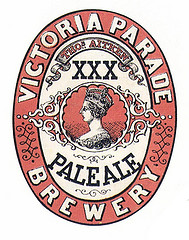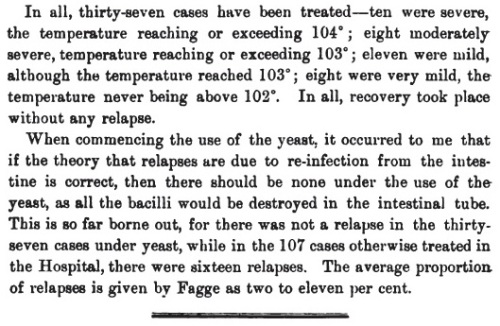In 1891, a flurry of medical interest followed the experiments of Auguste de Bavay, a 35-year-old Belgian chemist and yeast expert, who had moved to Melbourne, Australia in 1884 and quickly revolutionized the colony’s primitive brewing industry.
Dr. J. W. “Springy” Springthorpe was the Vice President of the British Medical Association, Victorian Branch (“Victorian” as in “Victoria, Australia”, thus this was basically the Melbourne Medical Association). To publicize a new use for his beloved Saccharomyces yeast, Monsieur de Bavay (he is universally referred to as “Monsieur de Bavay” in these articles) wrote a speech that was read by Dr. Springthorpe at the June 1891 meeting of the Victorian Branch.

In 1891 M. de Bavay was working for the Victoria Parade Brewery, makers of fine ales.
Earlier, M. de Bavay had become aware of an interesting sample of fluid, consisting of chyle (fat-rich lymph from the lymphatics that drain the intestines) from someone with a chest injury.
Some time last year, Dr. Cox introduced Dr. O’Hara to me, and submitted for analysis a milky-looking fluid, which they believed to be possessed of antiseptic and deodorising properties, this fluid having escaped from the thoracic duct through an ulceration.
There’s no indication of why Drs. Cox and O’Hara believed this, but M. de Bavay found that they might have been right. The fluid contained no culturable organism, except for a Saccharomyces yeast that he assumed was a contamination from his brewery work. Which it probably was, so the original fluid is irrelevant for what follows. But then…
Some six months afterwards, however, I examined these flasks again. To my surprise, though in every instance I had sown considerable quantities of the chyle, no bacteria had made their appearance in either medium. … To further test the power of these saccharomyces to resist the growth of bacteria, I mixed some germs of putrefaction with them. The result was, that the saccharomyces developed very rapidly, whilst it was difficult to find traces of the germs of putrefaction. Some of these saccharomyces added to matter undergoing putrefaction, and very foul smelling, removed the offensive odour in a very short time.
* * *
There’s no need to go through all of M. de Bavay’s results, which are presented in the June 1891 issue of the Australian Medical Journal, pages 351-360 (available at Google Books here). A synopsis was syndicated in various other publications (e.g the Montreal Medical Journal (1890), pages 631-632). The main points are as follows (I don’t know how much of this is true):
- Typhoid bacilli (what we now call Salmonella Typhi) produce more of their toxin under alkaline conditions. Toxicity was measured by taking bacterial cultures, heating them to kill the bacteria, and injecting them into guinea pigs.
- Under these conditions, most of the toxin precipitates into a solid, instead of remaining dissolved.
- Yeast produce acid as they grow.
- Acid is good, because it makes the typhoid toxin stay soluble, thus poisoning the bacteria themselves. This is similar to the way yeast eventually produce so much alcohol that the yeast themselves get poisoned.
- Also, typhoid toxin that stays in solution in the gut might have an additional benefit: activating the immune system to attack typhoid bacteria.
“Pasteur, Roux, Chantemesse, Vidal, Martin, Hankin, Salomon, Charrin, Ruffer, and others, have proved that immunity can be given to animals by injecting the soluble products of the life of the microbe. This is precisely the effect I claim for yeast, when its acid renders soluble the poison of typhoid and allows of its absorption. Consequently, the yeast is not the direct cause of the cure, but the means of bringing about an automatic vaccination of the tissues with the produce of the growth of the typhoid bacilli.”
- It’s perfectly safe to feed people large amounts of yeast, with regular food or by itself.
- Adding sugar makes the yeast work better. Particularly maltose, as found in barley.
- Dr. Matthew Barclay Thomson of the Alfred Hospital has “given a clinical trial to the cure thus recommended.” He’ll be presenting the results soon.
* * *
At the next month’s meeting, there was considerable discussion of this, followed by Dr. Barclay Thomson’s presentation of his clinical results, all taking up pages 402-407 of the July Australian Medical Journal (found in the same 1891 pdf file linked above). And here’s the electrifying conclusion:

Well, that sounds good!
And yet, I don’t see any further work on this would-be cure. It sounds vaguely plausible, particularly from the probiotic perspective, in a world without antibiotics. Dr. Barclay Thomson also says:
The striking difference between [the various drugs that have been used to attempt to destroy the germs] and the saccharomyces is the power the latter has of reproducing itself, in its passage through the intestines.
And another doctor points out in the discussion that during typhoid, evidence from the feces suggests that the normal bacteria have effectively been outcompeted and replaced by the typhoid bacteria. Maybe something else could outcompete typhoid! But it was not to be.
* * *
The Australian and New Zealand media certainly took note of these investigations. In fact, before his presentation to the medical society, M. de Bavay attracted attention from ordinary doctors and patients.
February 27, 1891: “A physician” interviewed for the Melbourne Argus expresses extreme distaste for the whole idea and suggests that the idea of yeast as an antibacterial agent was debunked 50 years ago.
March 18, 1891: The Argus reports the death of a patient being treated by Dr. Springthorpe with M. de Bavay’s fungal concoctions. However, this is not proof that the treatment is worthless.
July 4, 1891: A correspondent writes the Melbourne Age with evidence that yeast is useful for typhoid and other fevers. Apparently Edmund Cartwright, inventor of the power loom that so enraged the Luddites, had been a medical student. Cartwright wrote in his memoirs that when he was practicing in the benighted village of Brampton, Derbyshire, he gave yeast to a boy whose typhoid responded to no other treatment, and it worked great, especially for something that was affordable to the impoverished townsfolk of Brampton.
Of course, this would have been around 1775, so if it hadn’t spread into popular use over the ensuing century, it probably didn’t work. But it’s always good to give something a second try, when it can be improved by new scientific methods!

Disillusioned by his failure to cure typhoid, M. de Bavay left Victoria Parade and turned corporate, helping Foster’s accelerate mass production of its watery lager.





